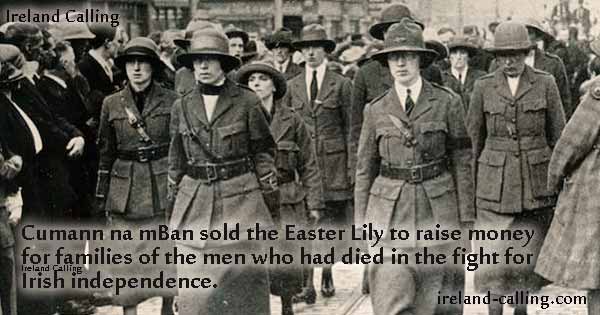The Easter Lily is a powerful symbol of peace in Ireland. It is traditionally worn over the Easter period, as an act of remembrance for people who died fighting for their country.
It originated in 1925, created by members of Cumann na mBan, which was an all-female organisation in support of the Irish Republican Army.
The Easter Lily was sold in front of churches on Sundays in the period before Easter, as a way of raising money to help support the families of the men that had died in Ireland’s fight for independence. It would then be worn as a mark of respect for those who had lost their lives, and also as a sign of hope and peace for the future.
The Easter Lily is a fitting symbol for Irish nationalists. It blooms in the springtime, which coincides with the anniversary of the 1916 Easter Rising, in which Irish rebels took control of major buildings in Dublin and declared Ireland an independent republic.
The British government responded with heavy military force and the two armies fought for about five days before rebel leader Padraic Pearse ordered his men to surrender to prevent any more casualties. During the conflict 64 Irish republicans and 254 civilians were killed, and 16 of the rebel leaders were executed in the following weeks. The British army suffered the loss of 132 men.

Hundreds of men lost their lives

Cumann na mBan created the Easter Lily nine years after the Rising. It was sold to raise money to help support the families that had lost their husbands and fathers. At the time, people in Ireland were still suffering the after effects of war. The Irish War of Independence had followed the Easter Rising, with an estimated 550 republicans and 750 civilians being killed.
Michael Collins, leader of the IRA, then signed the Anglo-Irish Treaty. The treaty allowed Ireland status as a free state, but as a dominion of the British Empire. This was unacceptable to some members of the IRA and the organisation split. The anti-treaty began fighting with their former comrades, the pro-treaty. This led to the Irish Civil War, during which Michael Collins was assassinated.
A note of warning
The Easter Lily can be deadly to cats. The entire plant (leaf, pollen and flower) can quickly cause kidney failure if eaten by a cat.
The Easter Lily is sold to remember the people who have lost their lives fighting for their country, and what they believed to be right. Its colouration of green, white and orange perfectly mirror the tricolour, the Republic of Ireland flag.
The green represents the ancient Celtic people, and the orange represents the Protestant settlers. With the white in between symbolises the peace and respect between the two.
The Easter Lily is also associated with the IRA and Sinn Féin, as a symbol to honour the men who have died fighting for their cause.
‘Pinheads’ and Stickies’
When the IRA split into two bodies of the Provisional IRA and the Official IRA, they both continued to wear the Easter Lily. The Provisional IRA members wore the traditional paper lily and pin, whereas the Official IRA would wear an Easter Lilly with a sticky back, just stuck onto their clothes. This led to brief nicknames of the two groups of ‘pinheads’ and stickies’, but they didn’t last long.
Celtic Cross
Brigid’s Cross
More on Irish Art
https://ireland-calling.com/irish-art/
https://ireland-calling.com/irish-art-roman-influence/
https://ireland-calling.com/irish-art-revival/
https://ireland-calling.com/irish-art-vikings-influence/
